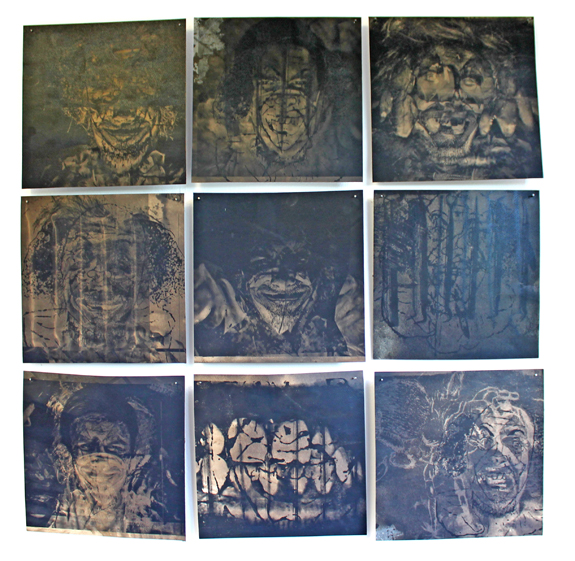| All Groups |
| - - - - - - - - - - - - - - - - - - - - - - - - - - - - - - - - - - - - - - - - - - - - - - - - - - - - - - - - - - - - - - - - - - - - - - - - - - - - - - - - - - - - - - - - - - - - - - - - - - - - - - - - - - |
 |
Ryan Davies- Understanding Architectural Materials and Space My aims for my FMP were to understand and contrast old and new architectural materials and space. I wanted to progress from my project 10 by experimenting more with architectural materials that are stronger and harder to work with.
|
|
 |
||
 |
||
| - - - - - - - - - - - - - - - - - - - - - - - - - - - - - - - - - - - - - - - - - - - - - - - - - - - - - - - - - - - - - - - - - - - - - - - - - - - - - - - - - - - - - - - - - - - - - - - - - - - - - - - - - - |
 |
Egle Sviderskaite - Dentists Ruin People's Lives This project is based on how fear affects different kinds of people. Fear isn't something that you can get over easily. It can prevent people from doing simple tasks, undermine people's confidence and jeopardize success. In extreme instances it can ruin people's lives. The way I approached the project was that I imagined I met a person who didn't understand fear and I was trying to explain it to them.
|
|
 |
||
 |
||
| - - - - - - - - - - - - - - - - - - - - - - - - - - - - - - - - - - - - - - - - - - - - - - - - - - - - - - - - - - - - - - - - - - - - - - - - - - - - - - - - - - - - - - - - - - - - - - - - - - - - - - - - - - |
 |
Dominic Saulter - Society Shoot Out This project Is based on Society Stereotypes looking at how people can be put into social groups purely by their appearance and how they can be rejected and put into different chains and orders of society , Starting by using google to explore the kind of descriptions and images that were shown when I searched in some of the society genres today , From this I then went on to look at different illustrative styles as this would be a way I would portray this theme into art work , Taking inspiration from Illustrators such Mike judge and Jay Howell who create fictional characters in the art world today I went on to create characters linking to my chosen stereotypes experimenting and taking inspiration from there cartoon based illustrative styles.
|
 |
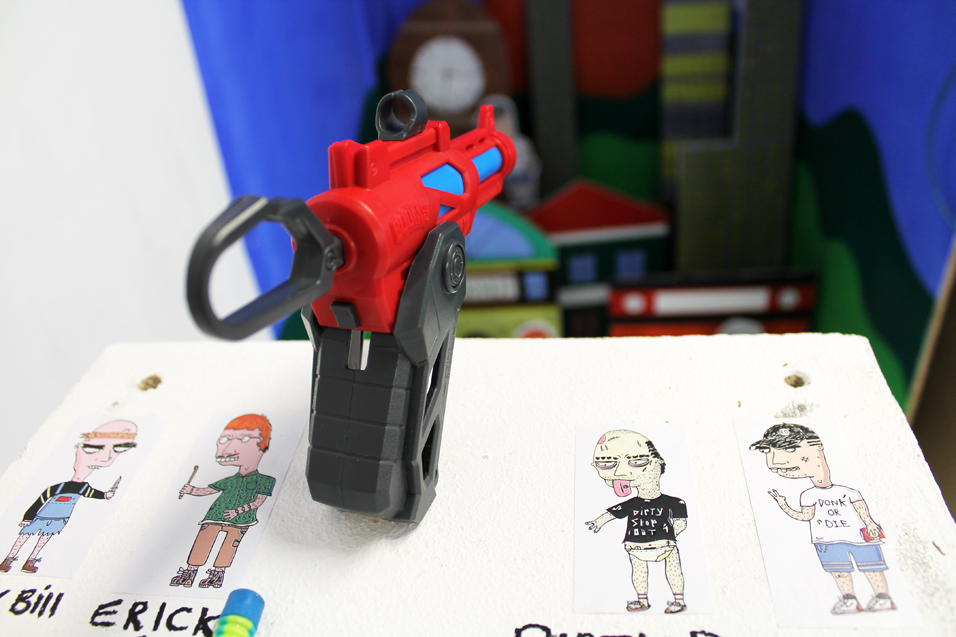 |
||
| - - - - - - - - - - - - - - - - - - - - - - - - - - - - - - - - - - - - - - - - - - - - - - - - - - - - - - - - - - - - - - - - - - - - - - - - - - - - - - - - - - - - - - - - - - - - - - - - - - - - - - - - - - |

|
Kathleen Hancox - Is Not Just A Fairy Tale A lot of people think that fairy tales are for children and nearly always have a happy ending which isn't always the case in real life. This project is exploring links between fairy stories and reality and focusing on the darker side of the fairy stories which often have a dark comment on reality. One of the ideas that I listed was the story of Rapunzel where I made links with obsessive and addictive behaviour and the consequences. And another that I chose out of the list being Rumpelstiltskin where behind the character, rumple is a greedy and selfish character that slightly persuades the millers daughter to make deals with the hidden cost and with reality there are many ways where people have the similar traits, however the political party of whom we rely on to make our lives better all have strong links to these characters. So after listing and combining the characters and politicians I explored the links between Michael Gove and Rumpelstiltskin through samples that range from
|
combining costumes from programs and illustrations from rumple and styles of suits, to working with alternative materials such as wood.
|
work o which has influenced me in different ways. Once I finished the Jacket that has both aspect of the project, I realised that I needed to do more to like with the political area so I heat pressed an article about Mike Gove and docking the teacher pay and used my Michael Land inspired drawing and laser cut a wallet and shoes. To link it in a different way I also made a scene of which Helen Musselwhite inspired me with which I made with brown card boar to keep the colours liking with each aspect of my exhibition.
|
||
 |
|||||
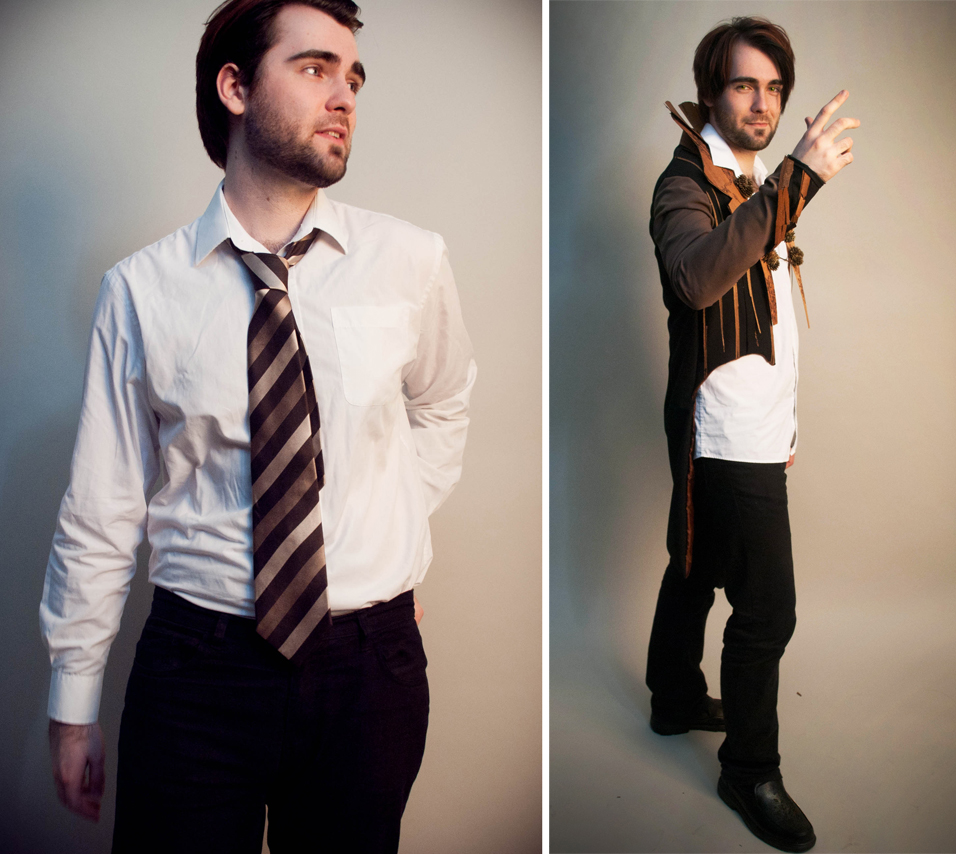 |
|||||
| - - - - - - - - - - - - - - - - - - - - - - - - - - - - - - - - - - - - - - - - - - - - - - - - - - - - - - - - - - - - - - - - - - - - - - - - - - - - - - - - - - - - - - - - - - - - - - - - - - - - - - - - - - |
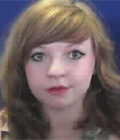 |
Shaylagh Sexton - Reinvention Many people have asked the question 'What is art?' and every artist has answered this in their own personal way. Some believe art should convey a social or political message whereas others believe it is purely about aesthetics. Personally, I feel that the best thing an artist can do is take an object that would normally be overlooked or discarded and release the potential it has to be beautiful. Marcel Duchamp first pushed the boundaries of the art world when he tried to submit a urinal into an art exhibition and was refused, and since many artists have used found objects in their work, particularly the Arte Povera movement which literally translates to mean 'poor art'. |
 |
 |
||
 |
||
 |
||
| - - - - - - - - - - - - - - - - - - - - - - - - - - - - - - - - - - - - - - - - - - - - - - - - - - - - - - - - - - - - - - - - - - - - - - - - - - - - - - - - - - - - - - - - - - - - - - - - - - - - - - - - - - |
 |
Lucy Moore - Family Portrait To start my project based around portraits I created a series of Pastiches from artists such as Francis Bacon and Jenny Saville, this helped me as I picked up on different techniques they used and it also helped me practice getting the proportions right. In this stage I practised using different mediums such as paint, graphite, charcoal and also ink. After creating these pastiches in different ways I then moved on to creating paintings from my own pictures, I took pictures and then tried to recreate the portrait using ideas and techniques from my pastiches. I didn't think this worked very well as I didn't capture the emotion the way I wanted to and I also don't think I used the right colours, I should have followed the same colour scheme as artists such as Jenny Saville, Francis Bacon and Lucien Freud. When this didn't work I decided to look into Jenny Saville more in depth so I thought of ways I could create one of her pieces but in my own way so I looked at the way she painted on her own face which I thought was very effective. To recreate this I painted on a student's face from my class with different coloured paints and then I photographed it, instead of doing drawings I decided I would do monoprints as it would be a little different and it would tie in nicely. After I had created a set of prints I thought about incorporating paint into them, instead of covering one completely in paint as I had done earlier I created one with hardly no paint and then build the rest adding more and more paint eachtime. After I had done this I documented it and I thought about how I could relate it to me personally, I came up with the idea of making it more family based so I took photos of my dad and sister and monoprinted them to A3 size, I did this twice and added paint to one and kept on just plain monoprint to show the difference between the two as one is more eye catching than the other one. In my exhibition I also included a pastiche of 'Bleach' by Jenny Saville which was created by everyone in my class; I feel this shows a link as I have a family at home and also a family in college. I feel like I could have included a lot more of my work in my exhibition but didn't have the sufficient space to include it all. |
 |
 |
||
 |
||
| - - - - - - - - - - - - - - - - - - - - - - - - - - - - - - - - - - - - - - - - - - - - - - - - - - - - - - - - - - - - - - - - - - - - - - - - - - - - - - - - - - - - - - - - - - - - - - - - - - - - - - - - - - |

|
Matthew Fearns - The Effects of Music I decided to use the theme of "The Effects of Music" as music is something I'm interested in. I felt that this theme would give me a challenge because it has been done before; therefore it would be harder to come up with an original interpretation. |
When starting my work I found it hard to think of techniques that I could experiment with, but I eventually thought of some abstract ones. After using these techniques I eventually came up with the idea of showing the reactions people have to different songs. I felt like the best way to do this while linking to my researched artists was to ask them 3 questions for each song and then using the answers as inspiration for a large scale illustration to convey what they were thinking whilst listening to the song. In the end, I asked 5 people to listen to 3 songs at random off of a playlist I had made with a variety of songs from a range of different genres. I then photographed them whilst listening to each song, and then after each song I asked them whether they liked the song, how it made them feel, and what it made them think of. I then used the final answer as inspiration for the A2 drawings I made and paired them up with the best image from the photo-shoot for my exhibition. I originally wanted to have MP3 players playing the songs from the drawings, but because of complications I ended up using QR codes, I think this is better than using the MP3 players though. |
In the end I am pleased with how the final pieces turned out and think I have linked to my research well and have shown what I have wanted to through my work. After having a group critique people have said they enjoy my work but have also made suggestions about what they think would made my work stronger. Unfortunately, I don't agree with what has been said or I am unable to make the changes they have suggested.
|
||
 |
|||||
 |
|||||
| - - - - - - - - - - - - - - - - - - - - - - - - - - - - - - - - - - - - - - - - - - - - - - - - - - - - - - - - - - - - - - - - - - - - - - - - - - - - - - - - - - - - - - - - - - - - - - - - - - - - - - - - - - |
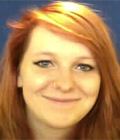
|
Rebecca Tyson - Meaning Over Beauty My exhibition is based on tattoos and the meaning behind them and why people get tattoos for the aesthetic aspect. I started looking at different artists who produced documentary style photography, such as Serena Giovanna Stevenson. Her work showed the culture behind tattoos'. For example I researched the Moko and Yakuza styles. I looked at certain models such as Kat von D and Zombie boy who made a living off their tattoos which didn't have meaning behind them. The tattoos were just there for their own sake. Then I did a few photo shoots in the studio to explore the beauty side and then asked questions about the tattoo's to see whether they had meaning and the reasons to them. I started looking at places that have influenced people to get tattoos and the reasons behind it to which I documented in my journal. |
I wanted to target different age groups so I photographed my step dad, as he has a tattoo of his dog. I asked him why he had it and he explained that it was like a child to him, this gave me the idea of creating a family tree. I based it on his family as they have a lot of tattoos that link to each other. The family members I looked at spanned across three generations. I explored different ways to lay this out because I didn't want a traditional family tree; I wanted one that I had designed myself. I wanted to include the beauty side of it so that it had some contrast and be simple and aesthetically pleasing. In laying out the final exhibition I used string to symbolise the connection and strength of the family bloodlines. On one side I wanted to make it look busy yet structured like a family can be. A contrast between chaos and order which I think sums up many families.
|
From doing the FMP one of the things I have discovered is that older generations have more life experience which enhances the beauty of their tattoos. Because their tattoos were less fashion driven their meaning is more important and more personal. Whereas people of a younger generation tend to see tattoos as fashion accessories. It has made me wonder how this will be seen in 10 years from now.
|
||
 |
|||||
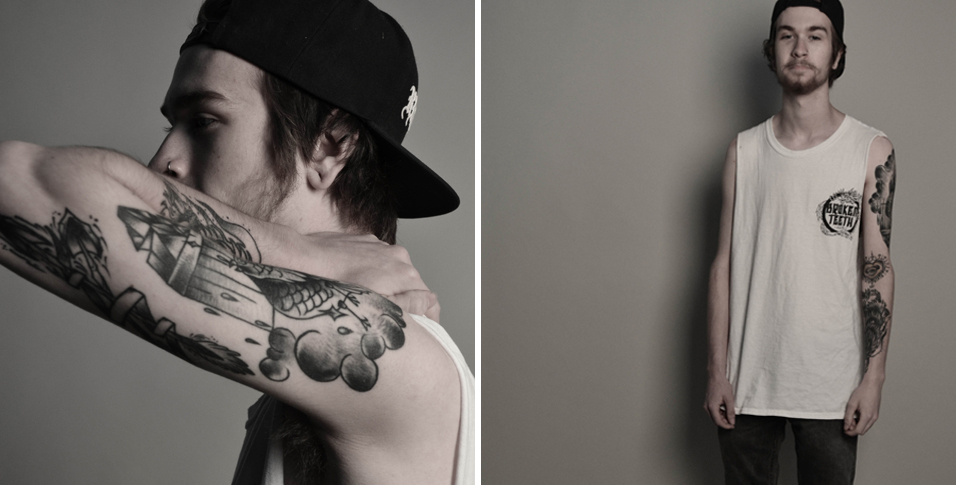 |
|||||
 |
|||||
| - - - - - - - - - - - - - - - - - - - - - - - - - - - - - - - - - - - - - - - - - - - - - - - - - - - - - - - - - - - - - - - - - - - - - - - - - - - - - - - - - - - - - - - - - - - - - - - - - - - - - - - - - - |

|
Emilio Dean Lisboa - Within the Human My original idea for my F.M.P was a metaphysical piece with an Atlantic theme much in the veins of Dali's 'Tuna Fishing'. Because I have an admiration for such stories as Moby Dick, The Old Man and the Sea and Homer's Odyssey I wanted to take the morels and themes of these tales and represent them through sublime allegories; mainly anatomy. I choose the concept of anatomy because it would have illustrated the story in a deeper and multi-layered perspective. Anatomy is a study of what's beneath; I wanted to go that direction in order to take my design skills to a more detailed and complex level that I never touched upon before; so my studies of the subject matter were quite intriguing. For the past 2 months I not only looked at art for inspiration but areas of anatomy and science and how it has been used in art. I looked at Di Vinci's anatomy drawings, Michelangelo and Raymond Pettibon for style influence, but I also touched upon the art of Pollock and Turner to get a better understanding of |
how represent atmosphere through expressive marks. However the product's style ascetics came from Vesalius' 'De Humani corporis fabrica libri septem' one of the earliest studies of the science of anatomy.
|
real pig's heart and a fish for reference; it seemed I was in a state of conflict, the original designs had potential and I didn't want to waste them. However I managed to those aspects and put them into each piece.
|
||
 |
|||||
 |
|||||
| - - - - - - - - - - - - - - - - - - - - - - - - - - - - - - - - - - - - - - - - - - - - - - - - - - - - - - - - - - - - - - - - - - - - - - - - - - - - - - - - - - - - - - - - - - - - - - - - - - - - - - - - - - |
 |
Eleanor Barr - Perspectives The concept of my Final Major Project is Perspectives. It was inspired by a piece seen in a Berlin Contemporary Art Gallery called 'The Flowering of the Rod' by artist Sara Barker. It was a metal installation placed on a wall and the shapes it was made of caused the overall view of it to change as you moved around it. As my interests are fashion and textiles, I wanted to take my interpretation of the piece and use the inspiration to create either a fashion outcome or textile art piece.
Something I thought that would be really important in displaying my exhibition is the lighting. Because of the lines of the piece, I knew that the right lighting would cast interesting shadows onto the wall behind it, hence why I wanted to exhibit my work in this particular space. I was inspired to use lighting by Hussein Chalayan, a designer who created two separate dress collections using both lasers and LED lights. As you can see, even though the final outcome is not a traditional, wearable fashion outcome, there have still been huge influences from people and techniques within the fashion industry. |
 |
 |
||
| - - - - - - - - - - - - - - - - - - - - - - - - - - - - - - - - - - - - - - - - - - - - - - - - - - - - - - - - - - - - - - - - - - - - - - - - - - - - - - - - - - - - - - - - - - - - - - - - - - - - - - - - - - |
 |
David Cunliffe - Signs of Humour For my work I looked at a range of artists for inspiration such as Clet Abraham, Roadsworth, Boris Bally etc. These artists gave me ideas to start my work. I wanted to change the way we look at road signs and to make people smile when they look at them.
|
 |
| - - - - - - - - - - - - - - - - - - - - - - - - - - - - - - - - - - - - - - - - - - - - - - - - - - - - - - - - - - - - - - - - - - - - - - - - - - - - - - - - - - - - - - - - - - - - - - - - - - - - - - - - - - |
 |
Kate Morris - Art Pop In the FMP I wanted to look at a specific spring 2014 trend called ART POP. I found this trend on Style.com and it is basically collections that are inspired or have some sort of connection with art.
|
 |
 |
||
| - - - - - - - - - - - - - - - - - - - - - - - - - - - - - - - - - - - - - - - - - - - - - - - - - - - - - - - - - - - - - - - - - - - - - - - - - - - - - - - - - - - - - - - - - - - - - - - - - - - - - - - - - - |
 |
Azaria Wright - The Artistic Interpretations Of Growth Through Natural Forms In Structures When I first started the project, the goal was to create a piece of work which engages and excites people while showing the development of growth through sculpture. Throughout this project, I have explored various artists that have influenced my work; David Nash in particular.
|
 |
 |
||
| - - - - - - - - - - - - - - - - - - - - - - - - - - - - - - - - - - - - - - - - - - - - - - - - - - - - - - - - - - - - - - - - - - - - - - - - - - - - - - - - - - - - - - - - - - - - - - - - - - - - - - - - - - |
 |
Katie Whitely - Consumerism During this project I've been looking into advertising and how the subconscious is affected by advertising of brands and how we as consumers are sucked into the brands imagery they create. I researched the sub consciousness with memory games at the beginning of the project to get an insight of how people react to memorising different brands, some more successful than others. This was useful and helped me understand how people saw the brands that I ended up painting and including in my final pieces. More research included looking at the phycology of colours which lead me to developing my use of colours in the logos. I felt that this was a successful path of development and I would have liked to take it further and develop more if given the chance again. For my final pieces I feel that they have all tied in well together representing the branding theme via film, 3D objects and 2D painting.
|
 |
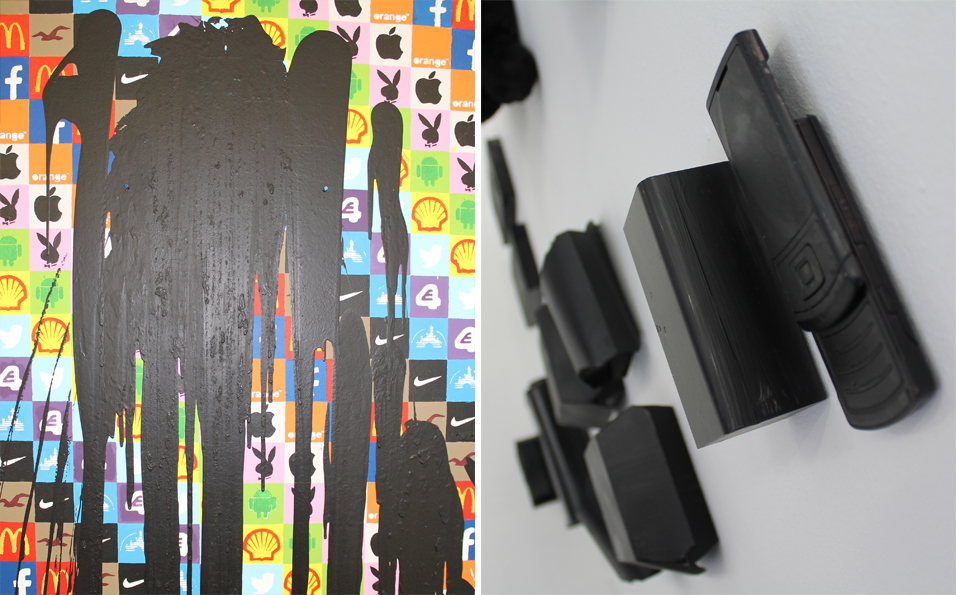 |
||
| - - - - - - - - - - - - - - - - - - - - - - - - - - - - - - - - - - - - - - - - - - - - - - - - - - - - - - - - - - - - - - - - - - - - - - - - - - - - - - - - - - - - - - - - - - - - - - - - - - - - - - - - - - |
 |
Emily Jones - Identity Through Perception My final major project is all about 'Identity through Perception'; this involved exploring an open theme of a person's identity, and the ideology behind perception. I have always wanted to use my huge collection of family photos and so I investigated traditional and digital methods to create a variety of manipulations. My initial starting points began by taking strong influence from illustration artists including Montana Forbes and Julian Opie; this lead me into doing simple, flat line drawings from the original photographs, as well as Photoshop manipulations making the people look more characterised. Most of my illustrative pieces developed from hand drawn pieces, to digitally Photoshop images. In order to experiment with the identity of the persons in the image, I experimented by removing their faces (as through my psychological research, I found that facial recognition was the main element into identifying a person). In response to looking at Claude Heath, I completed some continuous line drawings; these were then layered onto its original photograph, in the style of Picasso's light drawings. These layers influenced me, to develop the structure of layering pieces together, and so I completed a 'Dear Photography' task; for this I collected a selection of photographs (which dated back to 1991) and I took them back to its original setting where it was taken.
|
 |
 |
||
| - - - - - - - - - - - - - - - - - - - - - - - - - - - - - - - - - - - - - - - - - - - - - - - - - - - - - - - - - - - - - - - - - - - - - - - - - - - - - - - - - - - - - - - - - - - - - - - - - - - - - - - - - - |
 |
Claudia Reed - Imaginary Worlds For my FMP I called my project 'Imaginary Worlds' exploring the themes of utopia's and underworlds through questionnaires which were then created into illustrations. I explored four utopia's each with a specific person in mind, Lauren, Feilix, Mum and Sarah. Each piece was constructed with symbolic images, signs and symbols that are unique to each person. Each made from secondary sourced images to create inspired collages like illustrator Matt Maitland who created mixed collages. The main layout of the exhibition has been inspired from my pathway stage where I used same skills and techniques. It has been one of the main influences in my final exhibition. They gave my work a more subtle and professional look. During the first weeks of the project I found that the utopia experiments were not at the high quality I wanted them achieve. This made me rethink my plan and I decided just to develop and finalise the utopia illustrations instead.
|
 |
 |
||
| - - - - - - - - - - - - - - - - - - - - - - - - - - - - - - - - - - - - - - - - - - - - - - - - - - - - - - - - - - - - - - - - - - - - - - - - - - - - - - - - - - - - - - - - - - - - - - - - - - - - - - - - - - |

|
Katherine Hughes - Future Trend The concept and initial idea for my FMP, was to reflect a future trend through the use of paper. I chose this as my focus, as I'm always intrigued by various window displays and the ideas behind them. I also took an interest towards the idea of exploring the effects of visual merchandising and how certain looks/trends can be portrayed by a store, to capture the attention of its target audience. Whilst researching into a wide range of window displays by brands from around the world, I noticed that many presented their products through a narrative. Linking to the trend, almost like a scene from a story. Because of this, I decided that I would base my idea on creating a display which reflected my chosen trend, but also included some form of narrative which I think my target audience may relate to. |
Liverpool, taking in the different strategies that had been used to present a certain theme/trend. I then as a starting point began to experiment, by drawing a range of geometric forms. I then began photographing certain areas in college and around other places, where geometric shapes were present. From this I was able to begin collaging and experimenting with my ideas by putting them into Photoshop to create different patterns.
|
After deciding on a paper doll theme, I began researching into brands which I felt were suited to my theme and target audience. I decided on forever 21, as they feature the latest trends and many of their collections are aimed towards a young female audience. Due to my trend being forecasted for s/s, I decided that the concept of my display would also surround a holiday theme, going from 'day to night'. I then began researching into holiday wear and looked at street styles from abroad, which helped me decide what style of clothing I would include. I also experimented with different types of illustration to see which look I would use to create the doll, which would feature in my display. After deciding on which one I would include, I then used a projector so that I could draw my design onto wood. Once my design had been transferred, I added my final garments to the doll, along with accessories that I had created. |
||
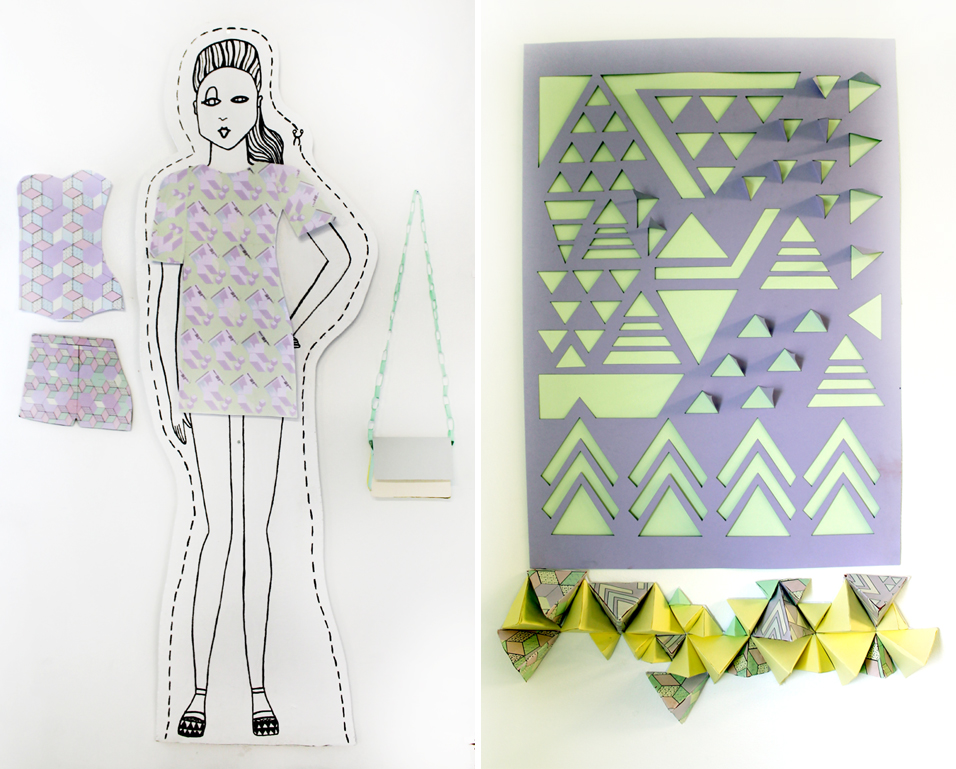 |
|||||
| - - - - - - - - - - - - - - - - - - - - - - - - - - - - - - - - - - - - - - - - - - - - - - - - - - - - - - - - - - - - - - - - - - - - - - - - - - - - - - - - - - - - - - - - - - - - - - - - - - - - - - - - - - |
 |
Lucy Davies - Dysmorphic For my project I looked at Dysmorphic body image and eating disorders. I wanted to explore the dysmorphic reflection people see when they are sufferers of disorders like Anorexia Nervosa. I wanted to link it, in a way, to the 'Project 10'. In that project I looked at crime, mainly that we commit against other people, in this project I wanted to look more at crimes we commit against ourselves by not liking ourselves, dieting and having an unhealthy diet.
|
 |
| - - - - - - - - - - - - - - - - - - - - - - - - - - - - - - - - - - - - - - - - - - - - - - - - - - - - - - - - - - - - - - - - - - - - - - - - - - - - - - - - - - - - - - - - - - - - - - - - - - - - - - - - - - |
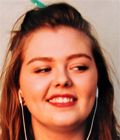 |
Jessica Lynsky - Beauty Indistruction My concept of Beauty in destruction has let me use a variety of techniques and materials within my work to look at whether destruction can be used as a form of creating artwork. Through a lot of experimentation within my project I have decided to do a series of statues and look at different ways of destroying them and seeing if they can still hold up as pieces of artwork within my exhibition. I chose the starting point of the Venus de milo as it links into the art history theme throughout my work as it is what I want to continue to do at university.
|
 |
 |
||
| - - - - - - - - - - - - - - - - - - - - - - - - - - - - - - - - - - - - - - - - - - - - - - - - - - - - - - - - - - - - - - - - - - - - - - - - - - - - - - - - - - - - - - - - - - - - - - - - - - - - - - - - - - |
 |
Stephanie Warbrick - Elegance and Indulgence – Rolling Deco The concept of my final major project was Elegance and Indulgence from looking in to the Rolling Deco showcasing the most stunning rides from the 1920s to 30s. Using photographs of rides from the Gatsby era, I developed stylised fashion illustrations by cutting up and collaging the shapes within the bodywork of the cars to produce designs with sleek innovative shapes reflecting the simplistic art deco age.
|
 |
| - - - - - - - - - - - - - - - - - - - - - - - - - - - - - - - - - - - - - - - - - - - - - - - - - - - - - - - - - - - - - - - - - - - - - - - - - - - - - - - - - - - - - - - - - - - - - - - - - - - - - - - - - - |
 |
Megan Frith - Berlin Branding The concept of my FMP was to convey my opinion of Berlin from my recent study trip to the city. I felt it was important to demonstrate the artistic energy and creativity of the culture of today as well as contrasting the dull atmospheric run down surroundings with the historic Berlin Wall which is a significant part to the city. Modebuch Berlin Fashion Book which I purchased while in Berlin has formed an importance of my concepts and interests throughout my journey.
|
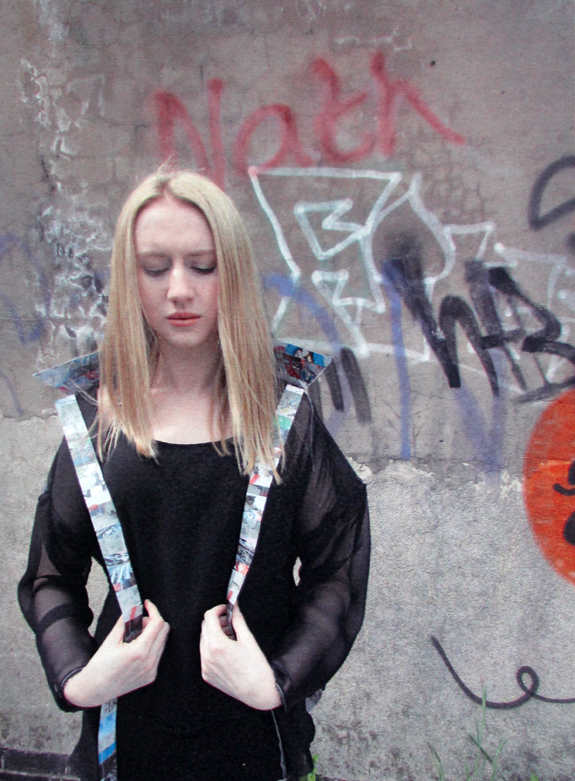 |
 |
||
 |
||
| - - - - - - - - - - - - - - - - - - - - - - - - - - - - - - - - - - - - - - - - - - - - - - - - - - - - - - - - - - - - - - - - - - - - - - - - - - - - - - - - - - - - - - - - - - - - - - - - - - - - - - - - - - |
 |
James Proctor - Psychology of Phobias For my final major project, I decided to create several pieces of abstract artwork demonstrating different psychological concepts (such as fear) that frequently appear in various media; these works were created using various physical media and Unity, a program normally used for game design. This challenged my creativity somewhat, as I was required to combine several concepts that I have never intentionally used together before, and the artwork I created had to portray and represent one specific psychological concept, as opposed to the multiple concepts that would be seen throughout everyday life or used together in other artwork. |
 |
 |
||
| - - - - - - - - - - - - - - - - - - - - - - - - - - - - - - - - - - - - - - - - - - - - - - - - - - - - - - - - - - - - - - - - - - - - - - - - - - - - - - - - - - - - - - - - - - - - - - - - - - - - - - - - - - |
 |
Lauren Brown - sticks In my FMP I wanted to focus on Interiors and Exteriors as individual elements and then work towards linking them together and creating opposites.
|
 |
| - - - - - - - - - - - - - - - - - - - - - - - - - - - - - - - - - - - - - - - - - - - - - - - - - - - - - - - - - - - - - - - - - - - - - - - - - - - - - - - - - - - - - - - - - - - - - - - - - - - - - - - - - - |
 |
Natalie Hassall - Objects of Fashion The view on today's woman figure is that 'every woman can be a super woman; a streamlined super-feminine warrior, landed from outer-space' – Fashion Zeitgeist, Trends and cycles in the fashion system page 89. The same cannot have been said in the 1870's: 'The affluence of the man, understated in charcoal grey cloth is all the more impressive thanks to the jewel at his side' – Jean Béraud – 1878. Reading Fashion Zeitgeist – Trends and cycles in the fashion system at the beginning of my project kick-started what is now the foundations of my Final major project; a show that collaborates how fashion was seen in previous years in comparison to now, with the twist of delivering the concept through a pop-up catwalk. I looked back into the pathway stages of the course, specifically project 10 and my extended project where I used techniques such as promoting and adapting t-shirts as well as creating my own t-shirts which stretched my knowledge and abilities, ultimately developing my concepts and making skills, getting me ready for university standard. |
 |
 |
||
| - - - - - - - - - - - - - - - - - - - - - - - - - - - - - - - - - - - - - - - - - - - - - - - - - - - - - - - - - - - - - - - - - - - - - - - - - - - - - - - - - - - - - - - - - - - - - - - - - - - - - - - - - - |
 |
Jodie Gorrell - Umbra, Penumbra, Antumbra With inspiration from my pathway project, I carried on researching into light and in particular the contrast of dark and light which links to the title of the project. I wanted to make a piece which could be an experience for the viewer. An artist I was most interested in is Bruce Nauman whose work I visited at a museum in Berlin. His piece was in a large empty room which was dark and cold upon entering, the piece was a structure in the centre of the room with little light within the piece.
|
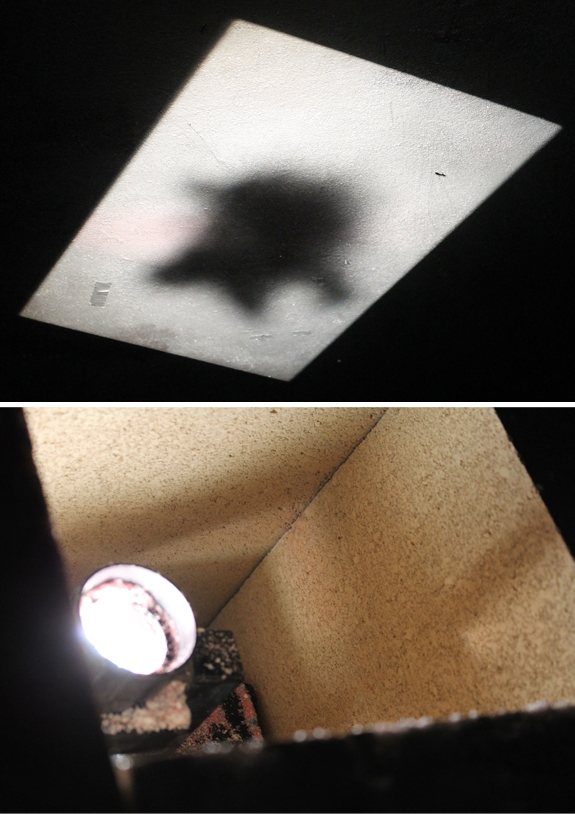 |
| - - - - - - - - - - - - - - - - - - - - - - - - - - - - - - - - - - - - - - - - - - - - - - - - - - - - - - - - - - - - - - - - - - - - - - - - - - - - - - - - - - - - - - - - - - - - - - - - - - - - - - - - - - |
 |
Bronwen Lovegrove - Reality For me this project has been a purely experimental and theoretical- it began simply with a title "reality" and that is the only starting point I had. My project took shape after researching artists Ryan Gander and Adam Curtis. Their exhibitions "Locked room" and "It felt like a kiss" influenced the visitors reactions and emotions without them knowing and even continued to affect their lives for months afterwards .Their work with the public is the main influence and force behind my work. During all my other projects and especially the pathway stage I hadn't really explored anything other than physical art and traditional methods for example sculpture architecture and human form. Although I love painting and drawing I found it refreshing and eye opening to take a different more contemporary approach compared to my pathway stage. My work is more documentary and contextual piece more about the process and the idea rather than an aesthetic outcome.
|
 |
 |
||
| - - - - - - - - - - - - - - - - - - - - - - - - - - - - - - - - - - - - - - - - - - - - - - - - - - - - - - - - - - - - - - - - - - - - - - - - - - - - - - - - - - - - - - - - - - - - - - - - - - - - - - - - - - |

|
Chloe Weightman - Documenting People In the beginning of my FMP I decided on the theme of documenting people over a certain time in their life to show how different people react to certain things going on in their life. I chose 3 individuals from Art Foundation to document which were all working with different pathways of Art and Design. There is Kathleen who has specialised in Costume making and Textiles, Claudia who has specialised in Illustration and Ryan who has specialised in Architecture. I planned to document each person in the same way asking them the same set of questions as the weeks went on to show their development towards their FMP as exhibition approaches.
|
The idea of the diary keeping came from the TV series 'My mad fat diary' shown on E4 based on a teenagers life. Alongside the diary keeping and the questions, I have photographed each individual's studio spaces each week to show the changes going from week 1 with their empty spaces right up to their exhibition spaces being complete.
|
getting from each persons. Ryan I say I got the least information from which explains his diary being lower than Claudia's and Kathleen's being like an open book to match the way her personality has been shown. I have included audio for each person asking them the same set of questions but displayed differently. Ryan's audio would be muffled so it's almost not understandable, Claudia's to be understandable but hard to hear and Kathleen's to be clear having it this way to match the layout of the diaries. The images displayed are from week 1 of studio spaces which are also displayed in the way to link to the rest of the set up.
|
||
 |
|||||
| - - - - - - - - - - - - - - - - - - - - - - - - - - - - - - - - - - - - - - - - - - - - - - - - - - - - - - - - - - - - - - - - - - - - - - - - - - - - - - - - - - - - - - - - - - - - - - - - - - - - - - - - - - |
 |
Jessica MacGlashan - Fit to Print The concept for my Final Major Project was fit to print where I could make repeat patterns to fit any surface but being from a fashion and textiles background I decided to print my design onto basic garments to liven each garment up. I made these designs on Photoshop and made repeat patterns. These design I made where from tracings, scanned images and collected tickets and maps from my trips to Berlin and London. From these I designed repeat patterns in Photoshop. These repeat patterns I made were a success I personally think and I also made samples based around the fashion designers and artist work I looked at and made little representation of each work I look at then sampled them. |
 |
| - - - - - - - - - - - - - - - - - - - - - - - - - - - - - - - - - - - - - - - - - - - - - - - - - - - - - - - - - - - - - - - - - - - - - - - - - - - - - - - - - - - - - - - - - - - - - - - - - - - - - - - - - - |
 |
Jessica Pierce - Perfect Landscapes When I first started this project, I set out to discover what makes a perfect landscape and to construct models. I wanted to see if the real beauty of a landscape was the natural form or the ways in which it is edited and adjusted to make it aesthetically pleasing. I did everything that I had set out to do in my statement of intent although some ideas did change but I stuck to my original idea of a perfect landscape. |
 |
 |
||
| - - - - - - - - - - - - - - - - - - - - - - - - - - - - - - - - - - - - - - - - - - - - - - - - - - - - - - - - - - - - - - - - - - - - - - - - - - - - - - - - - - - - - - - - - - - - - - - - - - - - - - - - - - |
 |
Joseph Thomas - Home, Work, Social and Holiday I started by looking into the work of Martin Parr and Tony Ray Jones and developing on their idea of stereotypical Britain. My idea I started with was just going to be of Skelmersdale and other similar areas, but looking into more depth and different areas that wouldn't necessarily be grouped together on first thought.
|
 |
 |
||
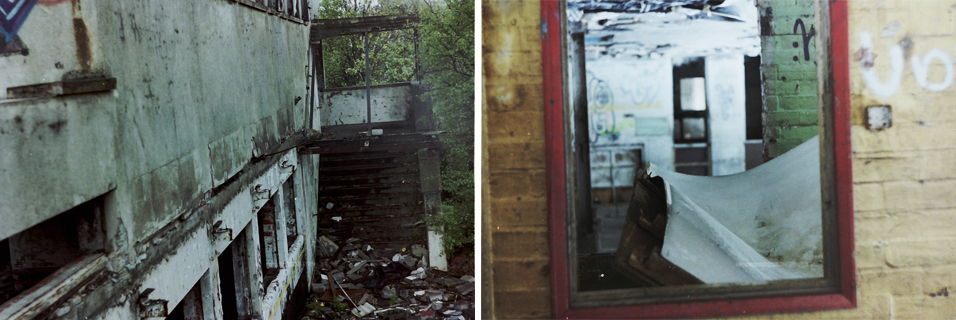 |
||
| - - - - - - - - - - - - - - - - - - - - - - - - - - - - - - - - - - - - - - - - - - - - - - - - - - - - - - - - - - - - - - - - - - - - - - - - - - - - - - - - - - - - - - - - - - - - - - - - - - - - - - - - - - |
 |
Mollie Ducharme - Nothing Really Matters Nothing Really Matters. |
 |
| - - - - - - - - - - - - - - - - - - - - - - - - - - - - - - - - - - - - - - - - - - - - - - - - - - - - - - - - - - - - - - - - - - - - - - - - - - - - - - - - - - - - - - - - - - - - - - - - - - - - - - - - - - |
 |
Saskia Tobiasen - The Space In And Around A Cube The foundation of my project comes from the work I did in my short project "10". The project was based around the idea of the space in and around a cube this was influenced initially by the work of Sol LeWitt. His work is largely based around squares and cubes in a variation of wall drawings and sculpture. I started by making small scale sculptures out of sugar cubes which I photographed and did quick sketches of which later worked towards larger scale pieces made from 2x2 and 4x4 wood that I created more permanent sculptures with that became a plan for my final piece. In this process I also looked at Rachael Whitereads 'Embankment'. |
 |
 |
||
| - - - - - - - - - - - - - - - - - - - - - - - - - - - - - - - - - - - - - - - - - - - - - - - - - - - - - - - - - - - - - - - - - - - - - - - - - - - - - - - - - - - - - - - - - - - - - - - - - - - - - - - - - - |
 |
Lauren Evans- I Like Art Foundation During the foundation course I have learnt new processes and developed on skills I already have which I have enjoyed doing. I feel as though I have been more independent than ever towards the end of the year as we started the FMP which I see as a positive aspect to the course as it will prepare me for my Illustration course at university in September. The class I have been working with throughout the past year were mostly fine art students and fine art teachers however my passion is illustrative art, with this in mind I felt I worked better independently. However I feel like I would have had a better opportunity to excel further if I was in a class that was more centred on illustration and graphic design which would have been more beneficial to my development in group critique. Overall I am really happy with my final pieces and the progression of my journals. I also think tutorials with Ann have made my annotations much more detailed and I can refer back to previous techniques and artists. She also suggested many artists that related to the topic of my project which helped a lot.
|
 |
| - - - - - - - - - - - - - - - - - - - - - - - - - - - - - - - - - - - - - - - - - - - - - - - - - - - - - - - - - - - - - - - - - - - - - - - - - - - - - - - - - - - - - - - - - - - - - - - - - - - - - - - - - - |
 |
Jack Gittins - Empty Spaces My initial ideas for this project were mainly based around video making and editing, in my previous pathway states and projects I worked with video in at least half of the projects and I realised this year that my main art media I want to carry on using through out the rest of my life if Video producing, I really enjoy the process of making a video; the travel and the places it takes you, the people you get to meet and the wide variety of subjects you can portray through the media. In this project I have also worked quite in depth into architectural illustration using Adobe Photoshop, I have learnt a lot more about myself and the skills to learn more that I possess. With my video making I have always been self taught throughout the years of on and off video making and this year especially this FMP project has been extremely effective for my skills and teaching myself new ways to do things and get around problems.
|
| - - - - - - - - - - - - - - - - - - - - - - - - - - - - - - - - - - - - - - - - - - - - - - - - - - - - - - - - - - - - - - - - - - - - - - - - - - - - - - - - - - - - - - - - - - - - - - - - - - - - - - - - - - |
![]()







